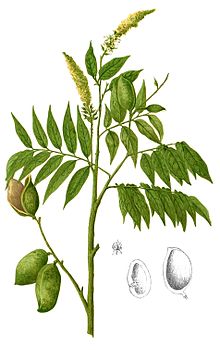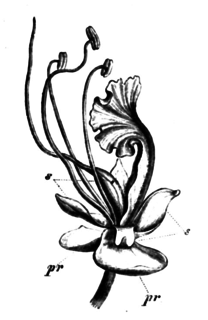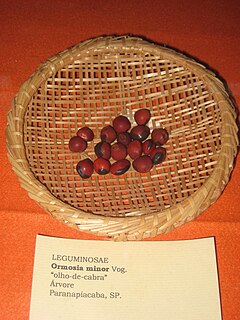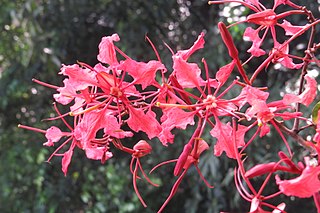| Crudia | |
|---|---|
 | |
| Crudia spicata | |
| Scientific classification | |
| Kingdom: | Plantae |
| Clade: | Tracheophytes |
| Clade: | Angiosperms |
| Clade: | Eudicots |
| Clade: | Rosids |
| Order: | Fabales |
| Family: | Fabaceae |
| Subfamily: | Detarioideae |
| Tribe: | Amherstieae |
| Genus: | Crudia Schreb. |
| Synonyms | |
| |
| Crudia | |
|---|---|
 | |
| Crudia spicata | |
| Scientific classification | |
| Kingdom: | Plantae |
| Clade: | Tracheophytes |
| Clade: | Angiosperms |
| Clade: | Eudicots |
| Clade: | Rosids |
| Order: | Fabales |
| Family: | Fabaceae |
| Subfamily: | Detarioideae |
| Tribe: | Amherstieae |
| Genus: | Crudia Schreb. |
| Synonyms | |
| |
Species accepted by the Plants of the World Online as of February 2021: [1]

Dalbergia is a large genus of small to medium-size trees, shrubs and lianas in the pea family, Fabaceae, subfamily Faboideae. It was recently assigned to the informal monophyletic Dalbergia clade : the Dalbergieae. The genus has a wide distribution, native to the tropical regions of Central and South America, Africa, Madagascar and southern Asia.

Bauhinia is a large genus of flowering plants in the subfamily Cercidoideae and tribe Bauhinieae, in the large flowering plant family Fabaceae, with a pantropical distribution. The genus was named after the Bauhin brothers Gaspard and Johann, Swiss-French botanists.

Macaranga is a large genus of Old World tropical trees of the family Euphorbiaceae and the only genus in the subtribe Macaranginae. Native to Africa, Australasia, Asia and various islands of the Indian and Pacific Oceans, the genus comprises over 300 different species. It was first described as a genus in 1806, based on specimens collected on the Island of Mauritius.

Litsea is a genus of evergreen or deciduous trees or shrubs belonging to the laurel family, Lauraceae. The genus includes a large number of accepted species in tropical and subtropical areas of North America and Asia.

Mesua is a genus of flowering plants in the family Calophyllaceae, native to tropical southern Asia. Common names include ironwood and rose chestnut.

Cynometra is genus of tropical forest trees with a pantropical distribution. It is particularly important as a forest component in west Africa and the neotropics. Cynometra alexandri (muhimbi) is a familiar timber tree of central and east Africa. The genus is a member of the subfamily Detarioideae. It has been suggested that Cynometra is polyphyletic and is in need of revision. In 2019, beside description of 4 new species, Aleksandar Radosavljevic suggested that the species formerly recognized as Maniltoa should be included in this genus and some of the mainland tropical African species excluded from this genus because of their jointed pedicels and dehiscent fruits.

Archidendron is a genus of flowering plants in the pea family, Fabaceae.

Macrolobium is a legume genus in the subfamily Detarioideae. It is a tropical genus with about 80 species. Half occur in Brazil, where they are common in the floodplains of the Amazonian Basin. Members of the genus are used as ornamentals and for their wood.

Ormosia is a genus of legumes. The more than 100 living species, mostly trees or large shrubs, are distributed throughout the tropical regions of the world, some extending into temperate zones, especially in East Asia. A few species are threatened by habitat destruction, while the Hainan ormosia is probably extinct already.

Madhuca is a genus of plants in the family Sapotaceae first described as a genus in 1791.

Parinari is a genus of plant in the family Chrysobalanaceae.

Vatica is a genus of plants in the family Dipterocarpaceae.

Salacia is a genus of plants in the family Celastraceae. They are woody climbers naturally found in tropical regions.

Dichapetalum is a genus in the plant family Dichapetalaceae. The plants are tropical lianas native mainly to tropical regions of Africa, Asia, Malesia, the West Indies, Australia and Latin America. Some species are known to be poisonous due to the presence of toxic fluorinated compounds such as fluorocarboxylic acid and dichapetalins, a unique class of cytotoxic compounds that are only found within this genus.

Phanera is a genus of flowering plants in the legume family, Fabaceae. It belongs to the subfamily Cercidoideae. This genus differs from Bauhinia in being vines or lianas, generally with tendrils and a lobed rather than spathaceous calyx, and from Schnella in having only three fertile stamens rather than ten, and being native to the Indomalayan realm and the Australasian realm rather than the Americas. The subsection Corymbosae was recently segregated into a new genus, Cheniella. It has been suggested that the genus Lasiobema should be reduced to a section within Phanera.
Hippocratea is a genus of flowering plants in the family Celastraceae, usually lianas, native to tropical and subtropical North America, South America and Africa.